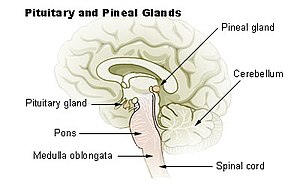Pineal gland

The pineal gland (named after the pine and the shape of its cones; also called conarium, corpus pineale, glandula pinealis, pineal organ) or epiphysis (cerebri) (from Greek: επίφυση, literally "the up-growth", "the sessile growth" with the Latin suffix cerebri - of the brain, as the bone ends of the long tubular bones are also called epiphyses), is a small unpaired organ in the epithalamus, a part of the diencephalon. In the pineal gland, the hormone melatonin is produced in special neurosecretory cells called pinealocytes. The hormone is mainly produced at night. The sleep-wake rhythm and other time-dependent rhythms of the body are controlled via melatonin. In case of malfunction, it causes - apart from a disturbed daily rhythm - either sexual prematurity or an inhibition of sexual development. Descartes believed the pineal gland to be the transition point between mind and body.
The development of the pineal gland from an anthroposophical point of view
The pineal gland is a metamorphosis of the heat perception and fertilisation organ of Lemurian man. In the early Lemurian period, before the detachment of the moon, the solid earth element did not yet exist. The human being lived as a still asexual being in the airy-liquid heat-permeated element, as it very similarly already formed the atmosphere of the Old Moon and was called fire-air (Ruach) by the alchemists. The biblical story of creation speaks of this, for example, where it says:
"... ruach elohim m'rachephet 'al p'ne hammájim (... And the Spirit of God was hovering over the face of the waters.)" (Genesis 1:2)
which could be more aptly translated as:
"... the spirit of the Elohim brooded over the material darkness."
Over the "waters", i.e. above the dark, denser liquid mass of matter, spreads the spiritualised, animated and living atmosphere of the fire-air, Ruach, which Rudolf Steiner also calls the primordial protein atmosphere in another context (the same chemical elements C, N, O, H, which today build up protein, are also still to be found in our present atmosphere).
In this atmosphere lives first the upper human being as a pure light-form, still completely open to the solar forces. This light-form descends into the lower human being formed from the dark masses of matter. While the upper human being is completely asexual, in the lower human being the two sexes are already slowly beginning to form. At first, however, the human being is still altogether an asexual being.
At the time of the separation of the moon, the lower human being was developed up to the sexual organs. At that time, the sun was in the constellation of Scorpio. Shortly before, when the sun was still in Sagittarius, the relationship between the lower and upper human beings was such that it is aptly described by the image of the centaur.
Literature
- Rick Strassman: DMT: The Spirit Molecule: A Doctor's Revolutionary Research into the Biology of Near-Death and Mystical Experiences. Park Street Press 2000, ISBN 978-0892819270
- Rudolf Steiner: Universe Earth and Man in their Relationship to Egyptian Myths and Modern Civilization. Reprint of the original edition. CW 105. Kessinger Publishing 2010, ISBN 978-1162581132
- Rudolf Steiner: Man as Symphony of the Creative Word. 3rd Revised edition. 12 lectures Dornach. CW 230. Translatation by V.& J. Compton-Burnet. Rudolf Steiner Press 1970. ISBN 978-0854402069 rsarchive.org
German
- Rudolf Steiner: Kosmogonie, GA 94 (2001), ISBN 3-7274-0940-1 English: rsarchive.org German: pdf pdf(2) html mobi epub archive.org
- Rudolf Steiner: Welt, Erde und Mensch, GA 105 (1983), Siebenter Vortrag, Stuttgart, 11. August 1908 English: rsarchive.org German: pdf pdf(2) html mobi epub archive.org
- Rudolf Steiner: Der Mensch als Zusammenklang des schaffenden, bildenden und gestaltenden Weltenwortes, GA 230 (1993), ISBN 3-7274-2300-5 English: rsarchive.org German: pdf pdf(2) html mobi epub archive.org
 |
References to the work of Rudolf Steiner follow Rudolf Steiner's Collected Works (CW or GA), Rudolf Steiner Verlag, Dornach/Switzerland, unless otherwise stated.
Email: verlag@steinerverlag.com URL: www.steinerverlag.com. Index to the Complete Works of Rudolf Steiner - Aelzina Books A complete list by Volume Number and a full list of known English translations you may also find at Rudolf Steiner's Collected Works Rudolf Steiner Archive - The largest online collection of Rudolf Steiner's books, lectures and articles in English. Rudolf Steiner Audio - Recorded and Read by Dale Brunsvold steinerbooks.org - Anthroposophic Press Inc. (USA) Rudolf Steiner Handbook - Christian Karl's proven standard work for orientation in Rudolf Steiner's Collected Works for free download as PDF. |
